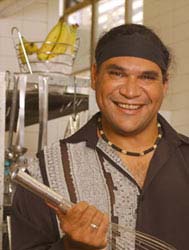
Photo: Celebrity chef Mark Olive was recently honoured at the 12th annual Deadly Awards, honouring excellence in Aboriginal and Torres Strait Islander music, sport, entertainment, the arts and community achievement.
Mark hosts The Outback Cafe TV show on Foxtel’s Lifestyle channel, specialising in indigenous Australian cuisine such as possum, emu and native plants.
In a thoughtful response to my last post on bush tucker Vic Cherikoff made the point that there is a huge distinction between bush tucker and authentic Australian ingredients in today's culinary world.
Vic noted that bush tucker covers the food resources of the 600 Aboriginal nations pre-invasion by the English and would include around 2000 different food items from the plant kingdom and perhaps 200 animal and insect foods.
Much of this food is only accessible on location and under the guidance of someone who knows the food stuffs and the area. There is a nice page on Warren Whitfield's The Great Greenway Eco Tours site that will give you a feel here. In Warren's words:
Some of the plant resources utilised by Aboriginal people follow (Please note that some plants contain toxins and irritants. Some plants require treatment prior to eating and not all are edible! DO NOT TRY ANY OF THESE WITHOUT PROPER SUPERVISION).
Vic contrasts bush tucker with Australian native foods, the term used to cover those bush food elements that have been commercialised since the 1980s when Vic and others began work on commercialising bushfoods, thus making them accessible to a wider audience. Since then a considered selection of indigenous foods have entered the market place.
I had not visited Vic's web site before he commented. It includes some fascinating material.
One of the challenges faced by Vic and other pioneers including Mark Olive lies in finding ways to fit ingredients that are both very ancient and new into cuisines that have not had access to them before. Many of the pioneers faced a chicken and egg problem in that they needed to demand to support development but could not attract the required demand without development.
As Vic pointed out, fortunately, we now have over two dozen authentic Australian ingredients forming a backbone of food resources for creative chefs to innovate and develop our own cuisine.


No comments:
Post a Comment